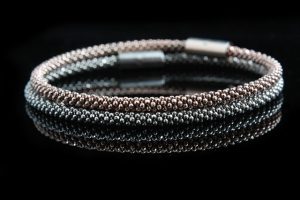 Men’s Bracelets
Men’s Bracelets
Men’s bracelets can be traced back to 9000 b.c., made from bone, stones or shells these were worn to fend off evil spirits.
Throughout the ages bracelets or armwear were worn for various purposes, to protect the wearer, as a symbol of status or as part of a military uniform. Bracelets evolved from protection or luck charm to a symbol of wealth to today where bracelets are worn as a style accessory for the modern man!
Wrist wear became more popular amongst men when watches, which were usually carried in a pocket secured by chain, were first worn inside a leather strap on the wrist. Early versions of the wristwatch were quite crude but offered a functional solution to the officers and men who joined the armed forces for the first world war.
Men’s wristwatches grew in popularity and were followed by more armwear when bracelets were introduced to the military in WWII. Post war interest in ID bracelets saw production and sales soar into the early 1950’s to be replaced in the 1960’s with the first wave of “friendship bracelets”.
In the late 1990 the first health bracelets made of copper and magnets surfaced and a new trend in Men’s bracelets started. In 2000 the Kaballa bracelet with its red string took the world by storm, there have since been a multitude of leather and cord alternatives.
Early in the 21st Century there was a plethora of social bracelets, often silicone usually supporting a cause. More recently friendship and leather bracelets have become fashionable with precious stones or metals as decoration.
Which arm? Men’s bracelets should be worn on the dominant hand if no watch is worn. If the watch is worn on the dominant hand the bracelet should be worn on the other wrist to avoid scratching the watch. With less constraint on style and fashion men can express their personality as freely as their f email counterparts!